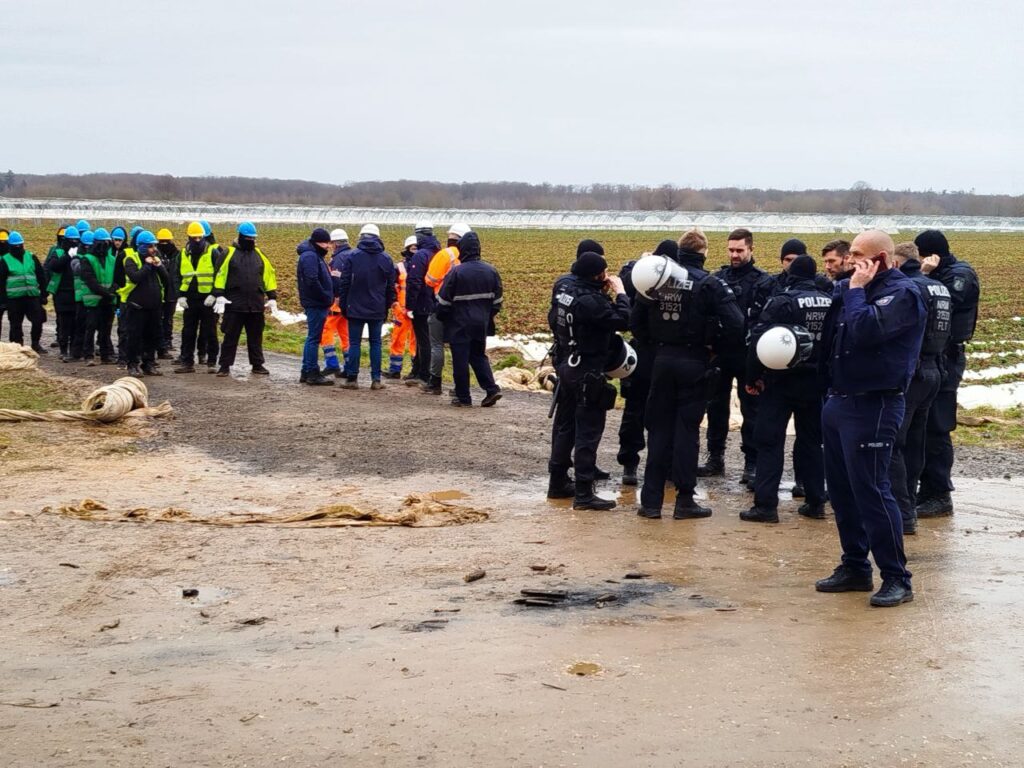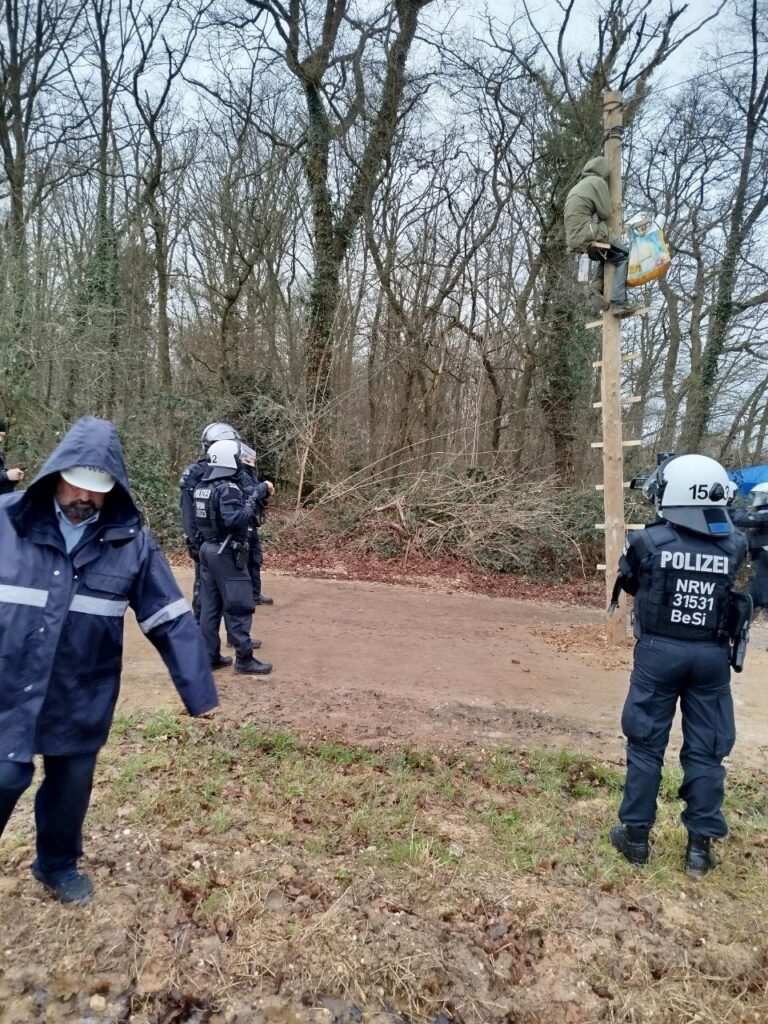Irre
Nach der weitgehenden Zerstörung des Sündenwaldes und der Vernichtung der ihn umgebenden Ökosysteme (Streuobstwiese, ehemaliger Sportplatz, Fliess, Randgehölze und historische Baumreihen); sowie den ständigen Attacken der rwe hörigen secus war kaum Zeit das Erlebte zu verarbeiten.
Sprachlos – Erschöpft – Verletzt
Wunden lecken, weinen, trauern, sich an anderen Orten erholen. Moment. An anderen Orten?
Ja, denn jetzt tut es manchen Wesen weh bei den geretteten Bäumen zu sein.
Früher, also noch vor 5 Monaten, da war die Welt im Sündi noch eine andere. Da war es schön, dort zu sein. Mit allen anderen Wesen, die auch dort waren. Schon fast 100 Jahre war dieses Waldstück vom nun bekannten Hambi getrennt. Eine eigene Welt, die es jetzt nicht mehr gibt.
Wir haben uns an das geklammert, was die Schlächter uns gelassen haben. Klar, wichtig. Erfolg!
Wir müssen aber mehr als das fordern. Nicht nur der Erhalt der besetzten Bäume ist unser Ziel.
Wir fordern Verantwortung, Verstand und Einsicht, also den Wandel!
Verantwortung zu übernehmen meint, die “See-Variante” sofort zu stoppen.
Diese Art der see-Befüllung verseucht unser Grundwasser zwischen Köln, Düsseldorf und Aachen!
Ein riesiges Gebiet, wo es in den nächsten paar hundert Jahren kein Trinkwasser mehr gefördert werden kann, weil nrwe uns die Grundwasserleiter mit Giftstoffen geflutet haben wird. Nicht nur die Gifte die im Rhein sind, sondern die, die durch das Abpumpen durch nrwe erzeugt wurden.
Der zuständige Wasserverband hatte zunächst gegen die Pläne erhebliche wissenschaftliche Einwände.
Aber nrwe schmiert gut und so ist jetzt der offizielle Sprech: Im Hinterland von Bielefeld wird genug Wasser gewonnen um den Verlust auszugleichen.
Das musst du dir mal vorstellen. Bielefeld, am anderen Ende von nrw, 200km entfernt.
Da wird doch auch überall gebaut. Und wenn eine Trasse, egal ob Autobahn, Gasleitungen oder Strom, wenn Trassen gebaut werden, kommt es immer wieder vor das Grundwasserleiter zerstört werden und Wasserquellen versiegen. Auch wenn Industrieanlagen in Wäldern gebaut werden (Windenergieerzeugungsanlagen sind Industrieanlagen und gehören deshalb in Industriegebiete. Da wird der Strom ja auch gebraucht…)
Aber auch das angelaufene Klimaroulette kann die gesamte Wasserversorgung in Frage stellen. Aber anstatt den Wasserverbrauch zu reduzieren und Wälder für die Wassererzeugung zu pflanzen wird “knapp auf Kante genäht”. Alle die sich mit Nähen oder Kleidung beschäftigen wissen davon. Davon, dass auf knapp genähte Nähte leicht reissen. Und wenn unsere Wasserversorgung nicht mehr ausreicht wird es teuer. Für uns.
Das Böschungsrutschen ist das nächste Problem. Von den großen Ingenieuren von rwe geplant, ist die Böschung zu steil. Für den See. Für die Rückbefüllung mit Abraum sind die Böschungen OK. Angeblich muss die Böschung (die Kante des Geländes hinab in den Tagebau) nur für spezielle Projekte verbessert (aufgeschüttet) werden. Nur, dass sich diese Projekte um den Tagebau herum vervielfältigen und dann irgendwann überall die Böschung stabilisiert werden muss.
Also, Abraumhalde zurück in das Loch, so wie es das Bergrecht von Bergbautreibenden fordert.
Das große Gebiet, das im Februar gerodet wurde, wird nun nicht mehr von den Wildtieren bewohnt. Deshalb haben sich auch die Zecken umgeschaut und sind jetzt in großer Zahl auf dem Weg oder schon im Bereich der besetzten Bäume. Du setzt dich auf den Waldboden und hast in kurtzer Zeit 5 Zecken die an dir krabbeln. Irre.
Nachts, wenn die Scheinwerfer der Bagger durch die verbliebenen Bäume hindurch leuchten macht es Menschen ganz traurig. In der ersten Aprilhälfte, mit dem vielen Wind, da war der Wind ganz irre. Laut und kalt flog der Wind durch die Bäume. Irre.
Wir erinnern uns an die Tage im letzten Jahr. Es war schon November als die Blätter massenhaft fielen. Danach wurde es windig. Das war einfach vorher nicht der Fall, dass es am Boden windig war. Der Sündenwald hatte sich selbst geschützt.
Jetzt stehen die besetzten Bäume alleine und ohne Schutz da. Irre.
Werden alle Vorstandsposten bei rwe von Irren besetzt?
Was kann Menschen dazu treiben, funktionierende Ökosysteme zu zermetzeln, ohne das es nötig war?Denn es hätte ja auch mindestens nächstes Jahr noch gereicht. Oder mehrere Jahre.
Oder auch gar nicht!
Denn Abraum gibt es genug. Ein ganzer Berg ist daraus entstanden. Seit mindestens 4 Jahren weis rwe, dass nicht weiter gebagert werden soll. Der bis dahin geförderte Abraum hätte für diese Zwecke direkt verwendet werden können. Und ansonsten kann rwe ja auch noch die Sofienhöhe zur Abraumgewinnung an- und abbaggern
Denn nach dem Gesetz, ja selbst nach diesem berüchtigten Bergesetz, was von “Rechtspflegern” über Grundgesetze gestellt wir, ja auch nach diesem Gesetz muß rwe den Abraum wieder in das Loch packen.
Ohne das geplante Müllverbrechen.
Sondermüll, zum Teil hochgiftig, soll zuerst ganz unten rein gekippt werden. Nichts mit überwachter Deponie, das ist seht teuer, und da rwe ja nrwe ist, sagt die Politik, dass das ein sehr guter Plan ist, weil der von nrwe ist.
Darüber soll eine 50m dicke Kalkschicht aufgetragen werden. 2-4 Kalkhügel an anderen Orten würden dafür vernichtet. die es nraucht, damit der Sondermüll nicht innerhalb der Haftungszeit (50 Jahre nach Beendigung der Förderung) nach oben kommt
Wohl nur diese Leute, die wissen, das es ein Verbrechen an der alten Natur war, was aber im Schatten des Wahlkampfes, verübt werden konnte. Jetzt besteht keine Gefahr mehr, dass der Sündenwald ein besonders schützenswertes Ökosystem ist.
Irre Leute am Werk. IRrweG.
Wir können nur hoffen, dass jetzt, wo das Drogenlabor in der rwe-Immobilie Haus Forst aufgeflogen ist, eventuell der Irrsinn ein Ende hat?
Kommt nrwe endlich zu Verstand?

















